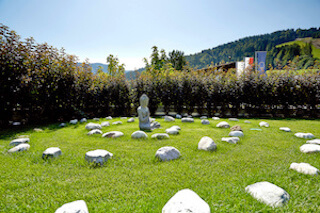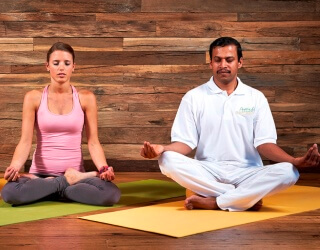A Beginners Guide to Meditation

© Ayurveda Resort Sonnhof, Austria
Contemplating and discovering the inner world is probably as old as humanity itself. It is about finding the inner nature of things and thus the connection to oneself and to the surrounding world.
No one is born a master.
Although, we all are no meditation gurus by nature, we can all learn meditation. With some willpower and perseverance, you can make your meditation practice part of your routine and find balance with your heart and your environment. This meditation guide is a good staring point.
What does it mean to meditate?
The western concept “meditation” is derived from Latin word ‘Meditari’ (to think, to ponder, to prepare for). Similar practices have been developed independently in all kinds of cultures. Accordingly, there are old European-Christian as well as Far Eastern meditation techniques, for example.
Meditation is a state beyond thinking.
Essentially, every meditation direction is about calming down, letting go of your burdens, and discovering what lies beneath these burdens. In the best case, one discovers the connection to oneself and to the environment and with this the realization that everything forms a unity. Especially rushing from one appointment to another and today’s flood of information can be quite a burden.
Your first meditation exercise
Meditating is really easy. But do not have too high expectations on your first attempts.
- Pick a place that seems right for you to settle down. It should be clean and tidy, not too cold or too warm, no disturbing noises and generally have a nice atmosphere.
- Take a pillow, blanket, seat pad or just a chair and make yourself comfortable. Your legs should not fall asleep, nothing should hurt, the spine should be straight and the head up. Find a relaxed position where you can imagine yourself staying in for several minutes.
- Set an alarm to 10 minutes. Depending on your personality, you may want to try it with 5 minutes at the beginning. It does not really matter, as meditation has nothing to do with compulsion or pressure to succeed. Whatever you achieve is perfect. What you cannot do is also fine.
- Now take a deep breath in the abdominal area. Just watch the breath and how it flows through your body. Feel it in the nostrils or on the lips.
- If thoughts are coming, just let them pass by. Imagine an unattractive TV program in your head that you do not want to see anyway, and just keep zapping. The only television program that interests you now is your breath.
- Stay here. Stay with it.
Find and learn the right meditation
As mentioned earlier, various meditation techniques have evolved over time, each of which has different paths to peace and unity.
In the following, I will briefly describe some of them. Once you get an idea, it is easier to choose your favorite technique afterwards.
Meditations focused on silence, mindfulness and insight
This branch of meditation is the one that is most known. This is mainly about first letting go of your burdens by deliberately omitting the stimuli. Thoughts are let go and thus the mind and the body are ‘slimmed down’ from all movements that might burden it.
Buddhist Meditation Traditions
Meditation and mindfulness practice are in the center of Buddhism. Vipassana, for example, means “Insight” into things as they really are, and meditation tries to find them in different ways.

The well-known Zen meditation belongs to Buddhism and, in simple terms, leads to the experience of absolute silence.
Christian Meditation Techniques
It is not as commonly known, but the Western Christian tradition also practices meditation. In the Middle Ages there were the 4 pillars called lectio (mindful reading), meditatio (non-objective intuition), oratio (prayer) and contemplatio (representational intuition). Today, for example, you can still find the Prayer of the Heart, which is based on a mantra and the regulation of breathing.
Hindu or Vedic tradition
It is this tradition that brought various schools of Yoga practiced today. As in Yoga classes, where the body is strengthened, cleansed, and connected to the mind by different asanas (body postures), mediation focuses on breathing and mental exercises.
Active or Dynamic Meditation
Interestingly, meditation has by no means anything to do with sitting still.
The unity with the body and the environment and the simultaneous detachment from the ‘I’ can also be achieved through moving exercises.
As in Qi Gong for example. This practice is one of the five pillars of traditional Chinese medicine and consists of various, mostly flowing movements that stimulate the so-called energy gates and meridians in a way that the body energy Qi is no longer blocked.
Laughter Meditation by Osho
When you wake up in the morning, stretch each and every fiber of your body for about 3 or 4 minutes. Keep your eyes closed and when the minutes have passed start laughing. At the beginning, you may need to force yourself to laugh and find it absurd, but that’s the way it is. Laugh at the absurdity of the situation.
As a first thing in the morning you should laugh,
because that is the decisive factor for the course
and the mood of the whole day.
The eyes must be closed. Lose yourself completely in your laughter. Laugh at yourself, at anything that seems ridiculous in life. Make your worries and frustrations seem ridiculous. At some point, you may come to a point where you observe yourself laughing, so to speak.
After a few days, this laughter will become very natural and you can start the day with a whole new feeling.
In conclusion
Meditation is a lot more versatile than you think, and yet most of the techniques have the same effect: throwing away the unnecessary weight of the everyday life and creating clarity and unity with the things that are essential. Especially for beginners, it seems important to know that this must never have anything to do with compulsion or success, as this only creates a new burden.
Whatever you do, I hope you enjoy your new-found inner self and balance.



